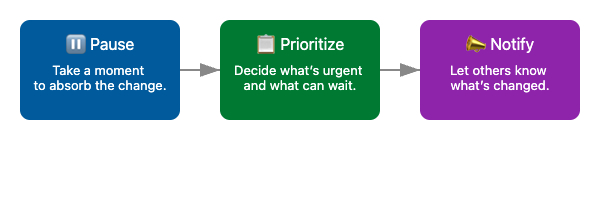Welcome to the world of Supporting Executives Through Change and Complexity.
Supporting your executive through change isn’t just about keeping up with a busy calendar — it’s about becoming their steady partner and trusted problem-solver when things get unpredictable. As the person who helps keep everything (and everyone) on track, you set the tone for how your executive and your organization navigates shifting priorities. Your flexibility, your communication, and your calm presence all shape how smoothly your team adapts when the ground is moving beneath you.
When you’re working alongside executives, change is the only constant. Priorities can shift in an instant, and your ability to stay composed, flexible, and proactive is what makes you indispensable. In this unit, you’ll explore the ins and outs of managing change from the perspective of an executive assistant. You’ll see that your role goes far beyond simply reacting to new requests. You’ll learn how to:
- Remain calm and adaptable when working with shifting executive priorities.
- Work effectively with high-demanding executives with clarity, confidence, and professionalism.
- Act as the connector between the executive and the team to keep everyone aligned, even when things are in flux.
- Stay flexible during last-minute changes to help everyone stay focused and steady.
You’ll explore practical strategies, real-world examples, and hands-on practice to help you support your executive with confidence — no matter what changes come your way.
Handling shifting priorities as an executive assistant is a bit like being the calm in the middle of a busy airport — flights get delayed, gates change, and you’re the one making sure everyone gets where they need to go without missing a beat.
When plans change at the last minute, your response sets the tone for everyone else. If you stay steady and solution-focused, it helps your executive (and the whole team) feel like things are under control.
For example, let’s say you’re deep into prepping for a client call, and suddenly your executive needs to switch gears for a project proposal meeting that just popped up. Instead of responding with "I don't know how I'll get this all done!, you might say "Absolutely, I'll shift my focus to prepare for the project proposal meeting. Would you like me to reschedule the client call?" Notice how this approach is calm, proactive, and focused on next steps. This response reassures your executive and keeps moving things forward.
When priorities shift, it’s your job to quickly reassess what’s urgent, what can wait, and who needs to know. It’s easy to feel pulled in every direction when things are in flux, but having a simple process can help you stay steady and effective.
Think of it like a workplace version of “stop, drop, and roll” — a quick, memorable way to respond to sudden changes. Here, we call it the Pause, Prioritize, and Notify method:
- Pause: Take a moment to absorb the change before jumping into action. This helps you avoid knee-jerk reactions and gives you a clear head to assess the situation.
- Prioritize: Quickly sort out what’s most urgent, what can wait, and what needs to be adjusted. Ask yourself: What absolutely has to happen now? What can be rescheduled or delegated?
- Notify: Communicate updates clearly and promptly to everyone affected. Let stakeholders know what’s changing, what the new plan is, and what you need from them.
This method helps you stay organized and keeps everyone aligned. Clear, timely communication reassures your executive and the team that you’ve got things under control, regardless how quickly priorities shift.

Being a reliable partner during change means staying calm, communicating clearly, and always being ready to adapt. When you approach shifting priorities with confidence and clarity, you not only support your executive, but you help the entire organization stay on track.
Here’s how you might demonstrate your role as a steady partner when priorities suddenly shift:
- Victoria: Jake, I know you were coordinating the team offsite, but we just got word that the board wants an updated financial summary by the end of the day. Can you help me pivot?
- Jake: Absolutely, Victoria. I’ll pause the offsite planning and shift my focus to preparing the financial summary. Is there any particular data or format you’d like me to use?
- Victoria: Please highlight our Q2 results and include a comparison with last year’s numbers.
- Jake: Got it. I’ll pull those figures and send you a draft within the hour. I’ll also notify the team about the offsite planning delay and share a new timeline.
- Victoria: Thank you, Jake. Your adaptability and clear updates really help keep everything running smoothly.
In this exchange, Jake uses the Pause, Prioritize, and Notify method: he pauses to clarify the new priority, quickly shifts his focus, and keeps everyone informed. By staying steady and proactive, he helps the whole team feel confident and supported, no matter what changes come up.
Up next, you’ll get to practice these skills in a realistic role-play, where you’ll navigate shifting priorities and show just how valuable your steady presence can be.
